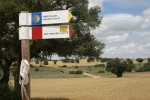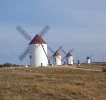Bachibouzouk
Active Member
- Time of past OR future Camino
- Voie de Soulac, Frances, De La Plata, Sureste/Levante, Manchego, Ruta del Argar.
Been trying to do some online research on these routes. Its all pretty skinny but some here have been of great help. I still have a number of questions.
I'll be setting off at the end of September. I've got 18 days.
Haven't decided on whether to set off from Valencia or Alicante. I'm open to persuasion. I fly into Valencia and would ideally like at least a couple of days there. I aim to walk as far as Toledo this year and have a day or two in Madrid before flying home to London. Allowing for a days travel on either end that leaves me with say 12 walking days.
Four days to get from Valencia or Alicante to Albacete.
From Albacete I want to follow the Sureste with some Quixotic diversions into Toledo. Something along the lines of:
Albacete to La Roda
La Roda to San Clemente
San Clemente to Belmonte
Belmonte to El Toboso
El Toboso to Don Faldrique via Campo de Criptana
Don Faldrique to Tembleque
Tembleque to Mora via Consuegra
Mora to Toledo
Long days, I know, but I like the heat and the distances. I carry about 6 kg (+2 litres of water), I'm a regular runner (up to 2 hours a day) and I've done the Camino de la Plata in June (hot but do-able). So here are some questions (not all Camino related but perhaps some here will know the answers).
1) Are there any museums in Valencia with anything by Salvador Dali? I can't find any indication that there are but would hate to miss anything that is there.
2) Any preferences between Levante or Sureste as far as Albacete? The first day out of Valencia doesn't appear to inspire anyone very much.
3) Is there anything related to the International Brigades in Albacete, other than the monument, to visit?
4) Any accommodation in Belmonte? It looks very small.
5) Are the hikes out to Campo de Criptana and Consuegra both worth the (long) detours?
6) Any recent guidebook, preferably in English, published on either of the two Caminos? Failing that where can I get a list of the albergues and hostales with their phone numbers?
Muchas gracias
Steve
I'll be setting off at the end of September. I've got 18 days.
Haven't decided on whether to set off from Valencia or Alicante. I'm open to persuasion. I fly into Valencia and would ideally like at least a couple of days there. I aim to walk as far as Toledo this year and have a day or two in Madrid before flying home to London. Allowing for a days travel on either end that leaves me with say 12 walking days.
Four days to get from Valencia or Alicante to Albacete.
From Albacete I want to follow the Sureste with some Quixotic diversions into Toledo. Something along the lines of:
Albacete to La Roda
La Roda to San Clemente
San Clemente to Belmonte
Belmonte to El Toboso
El Toboso to Don Faldrique via Campo de Criptana
Don Faldrique to Tembleque
Tembleque to Mora via Consuegra
Mora to Toledo
Long days, I know, but I like the heat and the distances. I carry about 6 kg (+2 litres of water), I'm a regular runner (up to 2 hours a day) and I've done the Camino de la Plata in June (hot but do-able). So here are some questions (not all Camino related but perhaps some here will know the answers).
1) Are there any museums in Valencia with anything by Salvador Dali? I can't find any indication that there are but would hate to miss anything that is there.
2) Any preferences between Levante or Sureste as far as Albacete? The first day out of Valencia doesn't appear to inspire anyone very much.
3) Is there anything related to the International Brigades in Albacete, other than the monument, to visit?
4) Any accommodation in Belmonte? It looks very small.
5) Are the hikes out to Campo de Criptana and Consuegra both worth the (long) detours?
6) Any recent guidebook, preferably in English, published on either of the two Caminos? Failing that where can I get a list of the albergues and hostales with their phone numbers?
Muchas gracias
Steve























